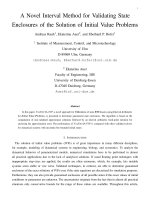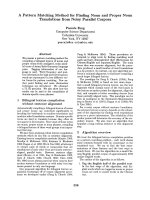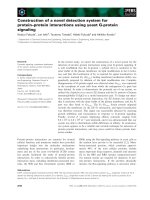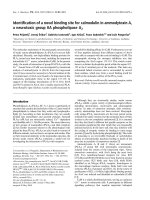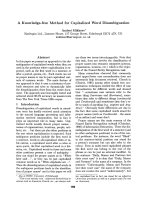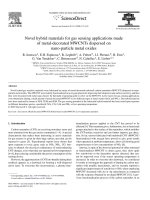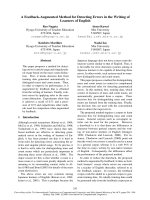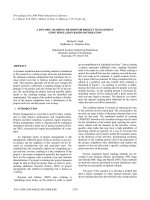A novel hybrid method for time series subsequence
Bạn đang xem bản rút gọn của tài liệu. Xem và tải ngay bản đầy đủ của tài liệu tại đây (480.38 KB, 5 trang )
2016 IEEE International Conference on Knowledge Engineering and Applications
A Novel Hybrid Method for Time Series Subsequence Join
Vo Duc Vinh, Nguyen Phuc
Duong Tuan Anh
Faculty of Information Technology
Ton Duc Thang University
Vietnam
e-mail: @studenttdt.edu.vn
Faculty of Computer Science and Engineering of Ho Chi
Minh city
University of Technology, Vietnam National University
Vietnam
e-mail: dtanh@cse. hcmut.edu.vn
Abstract-The exact method
time series subsequence join which is based on important
extrema to segment time series. And then, we apply a nested
loop join approach which uses a sliding window and Dynamic
Time Warping (DTW) distance to fInd all the matching
subsequences in the two time series within a similarity
threshold. Although this method executes very fast, it is an
approximate method and may have some false dismissals
because it might ignore some data points when shifting the
sliding window several points at a time.
Another recent work on subsequence join using the second
defmition which is proposed by Mueen et al. in 2014 ([7]) can
fInd the exact correlated subsequence. Mueen et al. introduced
an exhaustive searching method, JOCOR for discovering the
most correlated subsequence based on maximizing Pearson's
correlation coeffIcient in two given time series. Although the
authors incorporated several speeding-up techniques to reduce
2
the complexity from O(n4) to O(n Ign), where n is the length of
two time series, the runtime of JOCOR is still unacceptable
even for many time series datasets with moderate size.
In this paper, we propose a hybrid method for time series
subsequence join (using the second defInition) by combining
EP-M algorithm and JOCOR algorithm. First, we apply EP-M
to fInd the set of all pairs of matching subsequences in the two
time series within a similarity threshold. From this set we derive
the pair of subsequences which has the smallest distance
between them. The pair of subsequences is used as the
candidates of the most correlated subsequences in the two time
series. Finally, we apply the JOCOR algorithm to post-process
the candidates. The hybrid method helps to speed-up the
process of fInding the most correlated subsequence without
causing any false dismissals. The experiment results
demonstrate that our new hybrid method not only is nearly as
accurate as exact JOCOR but also achieves better time
efficiency when being compared to exact JOCOR.
JOCOR, proposed by Mueen et al.,
is the first method for joining two time series on subsequence
correlation. Although JOCOR requires the time complexity
O(n1lgn),
where
n
is the length of the time series, it is still
time-consuming even for medium-size time series. In this paper,
we propose a hybrid method which can run faster than JOCOR.
Our
method
consists
of
four
main
steps.
First,
a
list
of
subsequences is extracted from the raw time series based on
important extrema. Second, we apply a nested loop join using a
sliding window and Dynamic Time Warping distance to find
all
the matching subsequences in the two time series. Third, we
concatenate
al1
matching
subsequences
whose
indexes
are
adjacent into longer ones and find the pair of subsequences which
has
the
smallest
distance between
them.
Finally,
we apply
JOCOR to find the most correlated segments in the two time
series. In comparison to JOCOR, our hybrid method performs
much faster while high accuracy is guaranteed.
Keywords-correlation coefficients, dynamic time warping,
important extrema, JOCOR, nested loop join, subsequence join,
time series
I.
INTRODUCTION
Subsequence join over time series is considered as one of
the basic problems in time series data mining. This problem
appears in many practical applications such as entertainment,
meteorology, economy, fmance, medicine, and engineering [6].
The subsequence join over time series can be viewed in
different defmitions. The fIrst defmition of subsequence join is
based on a nested-Ioop algorithm and some distance function.
This joining approach returns all pairs 0/ subsequences drawn
from two time series that satisfy a given similarity threshold.
The second defInition of subsequence join is to fmd join
segments with maximum correlation coeJ
j icient and requires
only one parameter, the minimum length of the segments.
The approach based on the fIrst defInition has some
disadvantages such as time overhead because distance function
is called many times over a lot of iterations. To reduce the
runtime for nested-Ioop algorithm, some works tend to
approximately estimate the similarity between two time series
by dividing time series into segments. In this approach, Y. Lin
et al. ([6]) introduced solutions for joining two time series based
on a non-uniform segmentation and a similarity function over a
feature-set. Their method is not only difficult to implement but
also requires high computational complexity, especially for
large time series data. To avoid these drawbacks, in our
previous work [11], we proposed a method, called EP-M, for
978-1-5090-3471-0/16/$31.00 ©2016 IEEE
11.
A.
BACKGROUND
Basic Concepts
Definition 1. A time series T= tl, tb ... , tn is a sequence of n
data points measured at equal periods, where n is the length of
the time series. For most applications, each data point is usually
represented by a real value.
Definition 2. Given a time series T = t1, t2,…, tn of length n,
a subsequence T[i: i + m - 1] = ti, ti+1,…, ti+m-1 is a continuous
subsequence of T, starting at position i and length m (m n).
18
This work aims to join two time series T, and T2 of lengthn,
and nl. respectively. The problem of time series join was
defined by Mueen et al. [7] which is described as folIows.
Problem (Max-Corre lati on Join): Given two time series T,
and T2 of length n, and nl. respectively (assume n, ;::: n2), [md
the most correlated subsequences of T, and T2 with length ;:::
minLength.
When joining two time series, we refer to finding the most
correlated subsequence by calculating Pearson's correlation
coefficient. The correlation coefficient is defined as folIows.
procedure multiply produces an array that contains the sum of
the products of the elements in x and y for different shifts of x.
The output z of the procedure multiply is expressed more
precisely as follows.
Aigorithm Join(x, y)
// return the locations and
// length of the most correlated segments of x and y
1 x:= (x -mean(x»/stdv(x)
2 y:= (y - mean(y»/stdv(y)
3 n:= length(x); m:= length(y)
4 best:= 0
5 for i := 1 to m - minLength + 1 do
for j:= 1 ton - minLength + 1 do
6
7
maxLength:= min(m - i + 1, n - j + 1)
8
for len:= minLength to maxLength do
c:= Correlation(xUj +len-I], y[i:i +len-I])
9
(1)
where x and y are two given time series of equal lengthn, with
average values Jlx and Jly, and standard deviations ox and oy,
respectively.
The value of Pearson's correlation coefficient ranges in [-1,
1]. Besides, the z-normalized Euclidean distance is also a
commonly used measure in time series data mining. The
distance between two time series X = x f, x], ..., Xn and Y = Yf,
yl."" Yn with the same lengthn is calculated by:
10
Figure I.
n
d(x,y)=
L(X,_y;)2
I
I
where x = _ _ (x;- Jl ) and Y, = _ _ (YI - Jl )
x
y
,
(Jy
Because we just pay attention to maximizing positive
correlations and ignore the negatively correlated subsequences,
we can take advantage of the relationship between Euclidian
distance and positive correlation as follows.
C(x,y)=l-
d2;�y)
(3)
In this work, we will take advantage of statistics for
computing correlation coefficient as folIows.
(4)
d(x,y)= J2n(l- C(x,y))
>
best then best:= c
The brute-force algorithm for subsequence join over time series.
Aigorithm JOCOR(x, y)
// return the locations and
// length of the most correlated segments of x and y
1 x:= (x -mean(x»/stdv(x)
2 y:= (y - mean(y»/stdv(y)
3 n:= length(x); m:= length(y)
4 for i := 1 to m do
5
Zi:= multiply(x, y[i:m])
6 best:= 0
7 for i := 1 to m - minLength + 1 do
for j:= 1 ton - minLength + 1 do
8
9
maxLength:= min(m - i + 1, n - j + 1)
10
len:= minLength
11
while len � maxLength do
sumXY:= Zi[m-i +j] - Zi+len[m-i +j]
12
c := (sumXY - f..lxf!y)/(lenO'xO'y)
13
14
if c > best then best:= c
15
computestepSize
if stepSize � 0 orstepSize ;::: len then
16
17
stepSize := 0
18
len:= len +stepSize
(2)
i=1
{Jx
if c
(5)
This approach brings us two advantages. Firstly, the
algorithm just takes one pass to compute all of these statistic
variables. Secondly, it enables us to reuse computations and
reduce the amortized time complexity to constant instead of
line ar [7]. In the paper [7], the above formulas will be used for
computing correlation coefficient and z-normalized Euclidian
distance between two subsequences.
Figure 2. The JOCOR algorithm for subsequence join over time series.
Procedure multiply(x, y)
// return the shifted dot products
// for x and y (stored in z)
1 n':= length(x), m':= length(y)
2 x:= append(x, n' - zeros)
3 y:= append(reverse(y), (2n' - m')-zeros)
4 X:= FFT(x); Y:= FFT(y)
5 Z:=X.Y
6 z:= iFFT(Z)
B. J OCOR Algori thm
The main idea of JOCOR is to add some improvements to
the naive algorithm, Join, which finds the most correlated join
segments. The algorithm Join computes correlation of all the
possible pairs of segments of all the lengths. The pseudo-code
of Join algorithm is given as in Fig. 1.
To improve Join algorithm, JOCOR tries to reuse the
sufficient statistics for overlapping correlation computation and
then prune unnecessary correlation computation admissibly
(Fig. 2). JOCOR applies Fast Fourier Transform (FFT) to
compute the shifted cross product between two time series. The
Figure 3.
19
The procedure for computing the shifted cross product between two
time series.
m'
Zk = L Y, xk-m,+,
which is called compression rate. An increase of R leads to the
selection of fewer important extreme points.
Given a time series T of length n, starting at the beginning of
the time series, all important minima and maxima of the time
series are identified by using the algorithm given in [2]. The
algorithm takes linear computational time and constant
memory.
'�I
Here m' is the length of y and n' > m' is the length of x.
The procedure multiply aims to calculate Lxy in the fonnula
of computing correlation coefficient (4). Lines 4-5 in JOCOR
aim to populate a set of cross products Z where Zi = multiply(x,
y[i : m]). The cross products in Z are the most important
statistics for any correlation computation between any pair of
segments (Fig. 3). The dot product of two subsequences of x
and y starting at j and i -th locations, respectively, with length
len can be computed by Zi[m-i+j] - Zi+len[m-i+j].
The second important improvement of JOCOR is to use a
mechanism to skip some of the length in the loop of line 8.
JOCOR computes the step size dynamically instead of
incrementing of the len variable by one. Details of how to
compute this step size are given in [7].
C.
III. THE HYBRID METHOD FOR TIME SERIES SUBSEQUENCE
JOIN
Now we present our new hybrid method for time series
subsequence join which combines our previous method, EP-M
([11]), and JOCOR algorithm ([7]). The hybrid method exploits
the relationship between the two definitions of time series
subsequence join. The first definition of subsequence join has
the spirit of range search which finds all all pairs of
subsequences drawn from two time series that satisfy a given
similarity threshold th while the second definition has the spirit
of nearest neighbor search which fmds only the most correlated
pair of subsequences. But it is obvious that from the result of
range search, we can derive the result of nearest neighbor
search.
Based on the above-mentioned rationale, the hybrid method
consists of the following main ideas. Given two time series, first
we apply EP-M approach which fmds all the matching
subsequences in the two time series. Second, we concatenate all
matching subsequences whose indexes are adjacent into longer
ones. Then, we find the pair of subsequences which has the
smallest distance between them. Finally, we apply JOCOR
algorithm to the pair of subsequences obtained in the preceding
step to find the most correlated pair of subsequences.
Dynamic Time Warping Measure
In this work, we use Dynamic Time Warping distance since
this distance measure allows non-linear alignments between
two time series to accommodate sequences that are similar, but
locally out of phase.
Regarding the calculation of the DTW distance, the major
issue is that implementing it in the classical way, the
comparison of two time series of length I requires the
calculation of the entries of an I x I matrix using dynamic
pro�raming, and therefore the comparison has a complexity of
0(1). To speed up the DTW distance calculation, all
practitioners using DTW constrain the warping path in a giobai
manner by limiting how far it may stray from the diagonal. The
subset of matrix that the warping path is allowed to visit is
called warping window or a band. Two of the most frequently
used global constraints in the literature are the Sakoe-Chiba
band proposed by Sakoe and Chiba, 1978 [lO] and Itakura
Parallelogram proposed by Itakura, 1975 [3]. Sakoe-Chiba band
is the area defined by two straight lines in parallel with the
diagonal and Itakura Parallelogram is the area defmed by the
parallelogram which is symmetric over the diagonal.
In this work, we use DTW distance with Sakoe-Chiba band
r. Two time series subsequences Q and C are similar to each
other within threshold th if DTW(Q, C)::; th.
A. The Proposed Method
The hybrid algorithm for subsequence join over time series
consists of the following steps.
Step 1: We extract all important extrema of the two time
series T, and T2• The results of this step are two lists of
important extrema EPI = (epft, eph ... , ep1ma and EP2 =
(ep2" ep2l."" ep2m2) where ml and m2 are the numbers of
important extrema in T, and Tl. respectively. Afterward, when
extracting subsequences from a time series (T, or T2), we extract
the subsequence bounded by the extrema epi and epi+2'
Step 2: We keep time series T, fixed and for each
subsequence s extracted from T, we find all its matching
subsequences in T2 by shifting a sliding window of the length
equal to the length of s along T2 one data point at a time. We
store all the resulting subsequences in the result set S.
Step 3: At this step, we concatenate all the resulting
matching pairs at Step 2 if the indexes of these pairs are
adjacent. Then, we find the pair of subsequences which has the
smallest distance between them.
Step 4: At the final step, we will apply JOCOR algorithm to
calculate the Pearson's correlation coefficient and fmd the most
correlated subsequence among the candidate subsequences
found in Step 3.
Notice that our previous algorithm EP-M consists of Step 1
and Step 2 in the hybrid algorithm. The pseudo-code for
describing Step 1, Step 2, Step 3 and Step 4 in the hybrid
method is given in Fig. 4 and Fig. 5.
Procedure Subsequence_Matching invokes the procedure
DTW EA which computes DTW distance. The DTW_EA
D. lmportant Extrema
Important extrema in a time series contain important change
points of the time series. The algorithm for identifying
important extrema was first introduced by Pratt and Fink, 2002
[8]. Fink and Gandhi, 2007 [2] proposed the improved variant
of the algorithm for fmding important extrema. The concepts of
important extrema of time series in both the papers were used
for time series compression. But in this work, we exploit the
concepts of important extrema for segmenting time series into
subsequences.
In [2], Fink and Gandhi give the definition of important
extrema and the algorithm that can identify important extrema
from a given time series. Intuitively, an important minimum is
the minimum value of some segment and the endpoints of this
segment are much larger than it. Similarly, an important
maximum is the maximum value of some segment and the
endpoints of this segment are much smaller than it. The
definition of important extrema requires a positive parameter R
20
subsequence, the runtime of algorithm and the length of the
resulting subsequence.
procedure applies Early Abandoning technique as mentioned in
the next subsection.
A. Datasets
Aigorithm Hybrid (TI[l.. nl], T2[1.. n2])
Input: Two time series TI and T2
Output: The pair of subsequences which has the
maximum Pearson's correlation coefficient
l. EP 1 = Important_Extrema(TI);
EP2 := Important_Extrema(T2)
For i:= 1 to length(EP 1) -2 do
Subsequence_TI(i) := TI[EP 1 (i) to EP 1 (i+2)]
For i:= 1 to length(EP2) -2 do
Subsequence_Tli):= T2[EP2(i) to EP2(i+2)]
2. For i:= 1 to length(EP 1) -2 do
s := Subsequence_TI(i)
Subsequence_Matching (s, Tb threshold)
Store an the resulting pairs of subsequences in S
3. For each resulting pair of subsequences in S
ifthe indexes of the subsequences are adjacent then
concatenate these subsequences into
longer subsequences, and update the result set S
4. From the result set S, [md the pair of subsequences (SI,
S2) which has the smallest DTW distance between them.
5. Apply JOCOR Aigorithm to find the most correlated
subsequences in the pair of candidate subsequences (sI, S2)
found in Step 4.
Procedure Subsequence_Matching(s[l..m], T[l..n],
threshold)
Input: T is a time series, s is a subsequence and threshold
is the similarity threshold
Output: The set S of an matching subsequences
1 for i= 1 to n - m + 1 do
2 segment_o!_T= subsequence Ti,l+m-1
3 dtw_distance = DTW_EA(s, segment_oLT, threshold)
4 if (dtw _distance <= threshold) then
5
Store to the pair <s, segment_o!_T> to the result set S
6 endfor
end Procedure
Figure 1.
Our experiments were conducted over the datasets from the
VCR Time Series Data Mining archive [4] and from [7]. There
are 9 datasets used in these experiments. The names and lengths
of nine datasets are as folIows: Chromosome (999,541 data
points), Stock (2,119,415 data points), EEG (10,957,312 data
points), Random Walks (RW2 - 1,600,002 data points), Ratbp
(1,296,000 data points), LFS6 (180,214 data points),
LightCurve (8,192,002 data points), Currency (15,000 data
points) and Salinity (15,000 data points).
The datasets are categorized into two types. In the first type
of datasets, each dataset is a long time series. In this case, we
divide each time series into two equal halves. The first subseries
will be h The second one will be T2. In the second type of
datasets, each dataset is a medium-size time series. Datasets of
this kind are downloaded from VCR archive. The downloaded
dataset will be TI. Basing on TI, we randomly generate the
synthetic dataset T2 by applying the following rule:
Figure 4. The proposed method HYBRID.
In order to make meaningful matching between two time
series, both must be nonnalized. In our subsequence join
method, before applying the hybrid algorithm we use min-max
normalization to transform the scale of one time series to the
scale of the other time series based on the maximum and
minimum values in each time series.
B. Some Other Issues
xi = xi-1 |xi-1 - |
How to estimate the width of Sakoe-chiba band
According to the research by Ratanamahatana and Keogh,
2005 [9], too large a warping window constraint may hurt
accuracy rather than improving it. Their claim is summarized in
the remark "a fittle warping is good while too much warping is
bad." Following this suggestion, in this work, we use 2% as the
fixed width of Sakoe-Chiba band r in DTW distance calculation.
That means r is computed by the formula:
where
In the above formula, + or - is determined by a random
process. The rationale for the method to generate the dataset T2
from TI is that the dataset T2 should have a high probability to
be correlated with h
Time series data T2 is generated after the correspondent
dataset has been nonnalized; therefore, there is no effect of
noise in T2•
r= 0.02*max(length(subsequence,), length(subsequence2))
B. The Hybrid Method versus Exact JOCOR
When operating some task on very long time series, the
response time is one of the most challenging factors for
researchers. In this experiment, we plan to compare the
perfonnance of our proposed method with that of exact JOCOR.
The performance of each method is evaluated by three
measurements: the maximum correlation coefficient of
resulting subsequence, the runtime of the method, and the
length of the resulting subsequence. Because the lengths of the
resulting subsequences of the two methods are almost the same,
we exclude them from our comparison.
From TABLE I, with datasets Stock, EEG and
Chromosome, our hybrid method produced the same maximum
correlation values as the exact JOCOR. In average of an
experiments, the maximum correlation coefficients obtained by
the hybrid method reach nearly 100% similar to JOCOR's
How to speed up the calculation of DTW distance
To speed up the calculation of DTW distance, in this work,
we use Sakoe-Chiba band to constrain the warping path.
Besides, we apply Early Abandoning technique, proposed by Li
and Wang, 2009 [5] to accelerate the computation of DTW
distance.
IV.
The procedure for subsequence matching.
EXPERIMENTAL EVALUATION
We implemented the two methods in MATLAB and carried
out the experiments on an Intel(R) Core(TM) i7-4790, 3.6 GHz,
8GB RAM Pe. In experiment, we compare the performance of
our hybrid method to that of exact JOCOR on three
measurements: the correlation coefficient of resulting
21
acceptable time efficiency. The experimental results show that
our hybrid method runs faster than JOCOR while the accuracy
of our approach is nearly the same as that of JOCOR. We
attribute the high performance of the hybrid method to the
effectiveness of EP-M to perform the range search and apply
JOCOR to post-process the candidate subsequences obtained
from the EP-M.
As for future work, we intend to apply a new distance,
Complexity Invariant Distance (CID) [1], in the hybrid method
rather than DTW in order to improve its time efficiency.
results. These experimental results verified the correctness and
the accuracy of the EP-M method in time series subsequence
join even though EP-M is just an approximate method.
TABLE 1. EXPERIMENTAL RESULTS OF THE HYBRID METHOD AND JOCOR
OVER 9 DATASETS (RT: RUNTIME IN SECONDS; MC: MAXIMLM
CORRELATION)
Dataset
length=1000
RT
Stock
RW2
RATBP
LFS6
EEG
MC
length=4000
length=15000
RT
MC
RT
Method
MC
Hybrid
6
0.995
549
0.998
2349
0.999
17
0.995
565
0.999
>12hrs
N/A
JOCOR
12
0.966
74
0.973
2125
0.951
Hybrid
41
0.966
1026
0.976
10461
0.985
JOCOR
Hybrid
7
0.978
136
0.997
10885
0.999
22
0.984
3140
0.999
9488
0.999
JOCOR
22
0.992
352
0.986
1989
0.996
Hybrid
24
0.992
600
0.997
8076
0.998
JOCOR
17
0.877
393
0.890
13886
0.908
Hybrid
41
0.877
1095
0.890
43885
0.908
JOCOR
Hybrid
4
0.967
135
0.966
5961
0.966
14
0.977
1057
0.988
7480
0.966
JOCOR
5
0.976
47
0.992
1595
0.995
Hybrid
14
0.983
286
0.996
5670
0.997
JOCOR
Chromo
14
0.999
350
0.999
13907
0.999
Hybrid
-some
11
0.999
351
0.999
10030
0.999
JOCOR
Light-
9
1.000
561
1.000
1989
0.996
Hybrid
Curve
8
1.000
496
1.000
8078
0.998
JOCOR
Currency
Salinity
REFERENCES
[I]
[2]
E. Fink and H. S. Gandhi,"Important extrema of time series," in Froc. oj
iEEE int/. Conf on System, Man and Cybernetics, Montreal, Canada,
2007, pp. 366-372.
Regarding the runtime, our hybrid method outperforms
JOCOR for seven out of nine datasets. Especially, with
LightCurve dataset, in the experiment with 15,000 data points,
the runtime of our method was more than 4 times faster than
that of JOCOR. With the length of 4000, in average, the hybrid
method runs faster than JOCOR about 6.46 times. The
differences between the two runtimes of the hybrid method and
JOCOR are wider when the length of the datasets increases.
Nevertheless, with Chromosome and RATBP datasets, JOCOR
runs slightly faster than our hybrid method. This is because for
this specific time series, the early abandoning technique [5]
applied for DTW calculation had no effect in pruning off costly
distance computations and hence the time series had undergone
several DTW calculations before really beingjoined by JOCOR
algorithm.
V.
G. P. A. Batista, X. Wang, and E. J. Keogh, "Complexity Invariant
Distance for Time Series," in Proc. ojSIAM Int/. Conf on Data Mining,
20ll, pp. 699-710.
[3]
F. Itakura, "Minimum Prediction Residual Principle Applied to Speech
Recognition," in IEEE Trans. Acoustics, Speech, and Signal Froc, vol.
ASSP-23,1975, pp. 52-72.
[4]
E. Keogh, 'The VCR Time Series Classification/Clustering," URL
www.cs.ucr. edu/-eamonn/time_series_datal,2015.
[5]
J. Li and Y. Wang, "Early Abandon to Accelerate Exact Dynamic Time
Warping," in The international Arab Journal ojlnjormation Technology,
vol. 6(2),2009, pp. 144-152.
[6]
Y. Lin and M. D. McCool, "Subseries Join: A Similarity-based Time
series Match Approach," in Froc. oj FAKDD Intl. Conf on, 20iO, Part 1,
LNAI 6ll8, pp. 238-245.
[7]
A. Mueen, H. Hamooni, and T. Estrada, "Time Series Join on
Subsequence Correlation," in Froc. oj ICDM,2014, pp. 450-459.
[8]
K. B. Pratt and E. Fink, "Search for Patterns in Compressed Time
Series," in international Journal oj image and Graphics, vol 2 (1),2002,
pp. 89-106.
[9]
CA Ratanamahatana and E. Keogh,"Three myths about Dynamic Time
Warping Data Mining ",in: Froc. ojSDM'05, 2005.
[10] H. Sakoe and S. Chiba, "Dynamic Programming Algorithm
Optimization for Spoken Word Recognition," in IEEE Trans. Acoustics,
Speech, andSignal Froc., vol. ASSP-26,1978, pp. 43-49.
[11] V. D. Vinh and D. T. Anh,"Efficient Subsequence Join over Time Series
under Dynamic Time Warping " in Recent Developments in Intelligent
Information
and
Database
Systems,
Studies
in
Computational
intelligence, vol. 642. D. Krol, L. Madeyski, N. T. Nguyen, Springer,
2016, pp. 41-52.
CONCLVSIONS AND FUTURE WORK
In this paper, we proposed a new hybrid method to [md the
most correlated subsequences of two time series with
22
